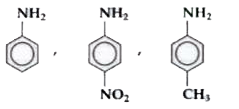Write chemical equations for the following conversions:
(i)CH3−CH2−ClintoCH3−CH2CH2−NH2
(ii)C6H5−CH2−ClintoC6H5−CH2−NH2
To convert the given compounds into their respective amines, we will follow a systematic approach for each conversion.
(i) Conversion of CH₃-CH₂-Cl to CH₃-CH₂-CH₂-NH₂
1. Starting Material: Ethyl chloride (CH₃-CH₂-Cl).
2. Reagent: React ethyl chloride with sodium cyanide (NaCN) in ethanol (C₂H₅OH).
- The reaction will replace the chlorine atom with a cyanide group, forming propanenitrile (CH₃-CH₂-CH₂-CN).
- Chemical Equation:
CH3-CH2-Cl+NaCNC2H5OH−−−−−→CH3-CH2-CN
3. Reduction: Next, reduce the propanenitrile (CH₃-CH₂-CH₂-CN) to propylamine (CH₃-CH₂-CH₂-NH₂).
- This can be achieved using lithium aluminum hydride (LiAlH₄) or hydrogen gas (H₂) in the presence of a catalyst.
- Chemical Equation:
CH3-CH2-CN+2H2Catalyst−−−−−→CH3-CH2-CH2-NH2
(ii) Conversion of C₆H₅-CH₂-Cl to C₆H₅-CH₂-NH₂
1. Starting Material: Benzyl chloride (C₆H₅-CH₂-Cl).
2. Reagent: React benzyl chloride with sodium cyanide (NaCN) in ethanol (C₂H₅OH).
- This will replace the chlorine atom with a cyanide group, forming benzyl cyanide (C₆H₅-CH₂-CN).
- Chemical Equation:
C6H5-CH2-Cl+NaCNC2H5OH−−−−−→C6H5-CH2-CN
3. Reduction: Finally, reduce benzyl cyanide (C₆H₅-CH₂-CN) to benzylamine (C₆H₅-CH₂-NH₂).
- This can also be done using lithium aluminum hydride (LiAlH₄) or hydrogen gas (H₂) with a catalyst.
- Chemical Equation:
C6H5-CH2-CN+2H2Catalyst−−−−−→C6H5-CH2-NH2
Summary of Chemical Equations:
1. For ethyl chloride to propylamine:
CH3-CH2-Cl+NaCNC2H5OH−−−−−→CH3-CH2-CN(1)
CH3-CH2-CN+2H2Catalyst−−−−−→CH3-CH2-CH2-NH2(2)
2. For benzyl chloride to benzylamine:
C6H5-CH2-Cl+NaCNC2H5OH−−−−−→C6H5-CH2-CN(3)
C6H5-CH2-CN+2H2Catalyst−−−−−→C6H5-CH2-NH2(4)
2. Reagent: React ethyl chloride with sodium cyanide (NaCN) in ethanol (C₂H₅OH).
- The reaction will replace the chlorine atom with a cyanide group, forming propanenitrile (CH₃-CH₂-CH₂-CN).
- Chemical Equation:
CH3-CH2-Cl+NaCNC2H5OH−−−−−→CH3-CH2-CN
- This can be achieved using lithium aluminum hydride (LiAlH₄) or hydrogen gas (H₂) in the presence of a catalyst.
- Chemical Equation:
CH3-CH2-CN+2H2Catalyst−−−−−→CH3-CH2-CH2-NH2
2. Reagent: React benzyl chloride with sodium cyanide (NaCN) in ethanol (C₂H₅OH).
- This will replace the chlorine atom with a cyanide group, forming benzyl cyanide (C₆H₅-CH₂-CN).
- Chemical Equation:
C6H5-CH2-Cl+NaCNC2H5OH−−−−−→C6H5-CH2-CN
- This can also be done using lithium aluminum hydride (LiAlH₄) or hydrogen gas (H₂) with a catalyst.
- Chemical Equation:
C6H5-CH2-CN+2H2Catalyst−−−−−→C6H5-CH2-NH2
1. For ethyl chloride to propylamine:
CH3-CH2-Cl+NaCNC2H5OH−−−−−→CH3-CH2-CN(1)
CH3-CH2-CN+2H2Catalyst−−−−−→CH3-CH2-CH2-NH2(2)
C6H5-CH2-Cl+NaCNC2H5OH−−−−−→C6H5-CH2-CN(3)
C6H5-CH2-CN+2H2Catalyst−−−−−→C6H5-CH2-NH2(4)
Topper's Solved these Questions
Similar Questions
Knowledge Check
The order of decreasing stability of the following carbanions is
(i) (CH3)3C−
(ii) (CH3)2CH−
(iii) CH3CH−2
(iv) C6H5CH−2A(i)gt(ii)gt(iii)gt(iv)B(iv)gt(iii)gt(ii)gt(i)C(iv)gt(i)gt(ii)gt(iii)D(iii)gt(ii)gt(i)gt(Iv)IUPAC name of C6H5−CH2−CH2−NH2
A2-phenyl ethanamideB2-phenyl ethanamineC2-phenyl ethylamineD3-phenyl ehtanamine
Write chemical equation for the following conversions :
(i) CH3−CH2CI→CH2−CH2−CH2−NH2
(ii) C6H5−CH2−CI→C6H5CH2CH2−NH2
View SolutionWrite the chemical reactions of the following conversions :
(i) CH3−CH2−Cl to CH3−CH2−CH2−NH2
(ii) C6H5−CH2−Clto C6H5−CH2−CH2−NH2
View SolutionThe most appropriate reagent for conversion of C2H5CN into CH3CH2CH2NH2 is :
View SolutionComplete the following reaction equations :
(i) C6H5N2Cl+CH3COCl→
(ii) C2H5NH2+C6SO2Cl→
(iii) C2H5NH2+HNO2→
View SolutionThe decreasing order of basicity of nitrogen in the following compounds is :
(a) CH3−CH2−NH2,C6H5−NH2,H2C=CH−NH2
(b) (C6H5)3N,(C6H5)2NH,C6H5NH2
(c) H2C=NH,HCN,CH3NH2
(d) C6H5NH2,C6H11NH2,C6H5CONH2
(e) C5H5N,C4H4NH,C6H5NH2,CH3CONH2
(f) C6H5N(CH3)2,C6H3(CH3)2N(CH3)2,C6H5NH2
(g) H2N−C6H4−OCH3,C6H5NH2,
H2N−C6H4−NO2,H2N−C6H4−CH2,
H2N−C6H4−Cl
(h) C6H5−C || NH−NH2, O2N−C6H4−C || NH−NH2Cl−C6H4−C || NH−NH2, H2N−C6H4−C || NH−NH2
View SolutionArrange the following in increasing order basic strength :
(i) C6H5−NH2,C6H5CH2−NH2,C6H5NH−CH3
(ii)
View Solution